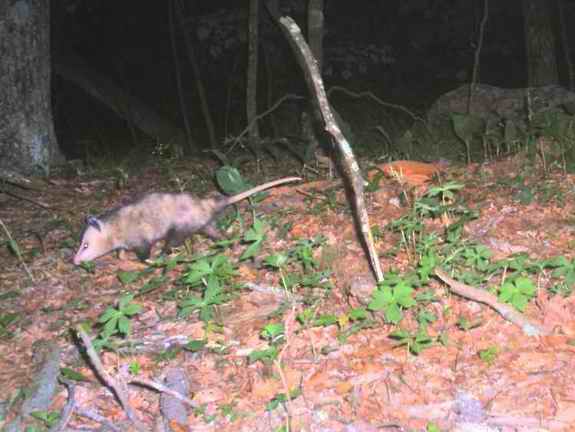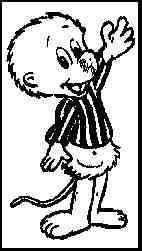|
Photo from Smithsonian Institution Megatransect of Appalachian Trail 2007
Return to Hiker's Notebook Home Page
Common Name: Opossum, Possum, Common opossum, Virginia opossum - The name is of Native American provenance and is from the Algonquian word apasum, which translates as "white animal." The coarse fir ranges from white in the northern reaches of its range to almost black in warmer regions.
Scientific Name: Didelphis virginiana - The generic name is from the Greek di meaning "two" and delphys meaning "womb." The opossum is a marsupial with a pouch that is used to nurture the young after gestation; it is metaphorically a "second womb." An alternative etymology for the genus is the fact that the female opossum has two uteruses. The species name refers to its original identification and description in the colony of Virginia by European naturalists defining the taxonomy of North American fauna.
The opossum is the only marsupial that is native to North America. It is characterized by its pointed white face with beady black eyes, coarse fir, and the scaly prehensile tail that extends for half its body length; the tail is used for grasping branches and for balance but is of insufficient strength to support the body of an adult (opossums do not hang by their tails). The importance of grasping branches to evolutionary success is manifest in a second notable characteristic; opossums have opposable thumbs on their hind feet, an attribute they share only with primates and a very few other species. Opossums have 50 teeth, more than any other North American mammal.
The marsupial mammals of the order Marsupialia are considered more primitive than the placental mammals; marsupials are characterized by the presence of a pouch called a marsupium (from the Greek marsypion meaning pouch from the Iranian marshu meaning belly) on the abdomen of the female with teats to nurture the young. The now ubiquitous placental mammals came somewhat later, the nurturing of the young in an umbilical fed placenta perhaps providing a measure of reproductive and hence survival advantage. The marsupials are of especial interest to evolutionary biologists owing to their geographic dispersion and diversity.
The oldest marsupial fossils are 100 million years old, dating from the late Cretaceous Period at the end of the Mesozoic Era. According to the plate tectonic theory and its attendant continental drift, the Mesozoic Era was punctuated by the breakup of the supercontinent Pangea; the northern portion became the protocontinent Laurasia (North America and Eurasia) and a southern landmass the protocontinent Gondwanaland (South America, Africa, Australia and Antarctica). The marsupials which originated in Laurasia spread south through Gondwanaland. The emergent and competing placental mammals expanded their range in parallel, overwhelming the marsupials due to a combination of factors including greater intelligence and an apparently more successful extended gestation reproductive system. At the dawn of the Cenozoic Era 65 million years ago Laurasia and Gondwanaland gradually broke up into the present six continents.
The geographic dispersion and diversity of marsupials is a reflection of the geologic record. There are about 175 species of marsupials on the island continent of Australia and in the environs islands of New Zealand, Tasmania, New Guinea, Timor and Celebes. This is attributed to the separation of Australia from South America before the southern migration of the placental mammals. The marsupials of Australasia are broadly representative of most major placental mammal types, ranging from pouched mice to wombats, kangaroos and koalas. The similarity in the adaptations of placental mammals and marsupial mammals is called convergent evolution; examples include the marsupial wombat and the marmot and the Tasmanian wolf and the gray wolf. South America has about 66 species of marsupials, all members of the family Didelphidae, the opossums. About 3 million years ago, South America and North America became joined by the isthmus of Panama. It is postulated that the Virginia opossum migrated north and evolved as the only marsupial to thrive among the placentals.
That the Common opossum is the only marsupial to thrive in North America is testimony to its adaptability, to its prodigious and nurturing reproduction and to the diversity of its defenses against predators. The adaptability of the opossum is evidenced by the diversity of its diet, it is the epitome of the omnivore and will eat almost anything that is organic, including but not limited to insects, snails, small mammals, fruit, eggs, fledgling birds, and, on occasion, cultivated crops. Homeowners near wooded areas are cautioned not to put pet food or any other scraps out lest they attract the unwanted attentions of an opossum. They make their homes in the hollows of trees, taking advantage of their prehensile tails and grasping rear feet to navigate their arboreal habitat. They build nests, often using their tails to transport leafy bedding materials to the selected site.
The female opossum is fertile at age 6 months and can produce up to two litters a year of about a dozen each; the gestation period is only about two weeks. The young are not born in the pouch but instinctively crawl there from the uterus; this is no mean task as they are blind, naked and weigh about 2 grams each, about the size of a bumblebee. Those that make it to the pouch seek out one of the 13 nipples (12 in a circle with 1 in the center) to which they are inexorably attached for about a month. The mother cares for the young for an additional two months, carrying them around on her back. Although senescence is rapid (the average life span of an opossum is only about 3 years), the population is adequately replenished by the fecundity and nurturing nature of the species.
Opossums are survivors - a fact that is evidenced by their role as the only marsupial mammals in North America. This is in part because of their singular defenses against predators, the most well known is the fright-induced involuntary comatose state that is the etiology of "playing possum." The mimicry is quite convincing. They become stiff, their teeth are bared, and they emit a mephitic fluid from glands near the anus; they look, feel and smell like a dead animal. A less extravagant defense is used to deter aggression from less egregious threats; the opossum will either work its jaws to produce excessive saliva to simulate a rabid sickness or draw back its lips to bare its full suit of sharp teeth. In addition to the overt defenses, opossums have an immune system that is at least partially resistant to the venom of pit vipers.
The opossum was one of the first of the "New World" animals to be brought back to Europe by the early explorers; Vicente Pinz�n, the commander of Christopher Columbus's ship Nina brought an opossum back to the Spanish Regents Ferdinand and Isabella, describing it as a "monster" with the "hinder of a monkey, the feet like a man's, with ears like an owl; under whose belly hung a great bag, in which it carried the young." As the Europeans had never seen a marsupial (there are none in Eurasia or Africa), the opossum came to epitomize the exotic fauna of the Americas. Sixteenth Century engravings of the opossum, such as �tienne Delaune's "America" depicted the peculiar animal as chimerical, with sharp fags and exaggerated claws. Over the course of the next century, the myriad novel plants and animals of the New World inspired the nascent science of comparative anatomy, with the resultant taxonomy of Linnaeus and evolution of Darwin. The opossum was transmogrified from monster to mammal by Edward Tyson of the Royal Society who described the anatomy of the female opossum in a treatise in 1698. He correctly surmised that the "feet like a man's" were for grasping and the "great bag for the young" was a manifestation of maternal care. The opossum was redeemed. The opossum is iconic to the culture of the American South, notably in the hill country, where it is hunted as a game animal and consumed with gustatory zeal according to recipes that have endured for generations. It is also eaten on several of the Caribbean islands, where it is known as manicou. Opossums have even appeared in politics. In response to the Bull Moose Party's "Teddy Bear" Roosevelt, the Republican Party countered with "Billy Possum" Taft. Walt Kelly chose an opossum as his main character, Pogo Possum, the kindly denizen of the Okefenokee Swamp who famously said "we have met the enemy and he is us." . |

